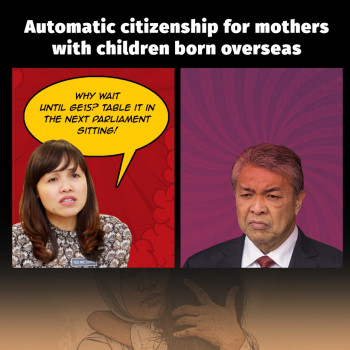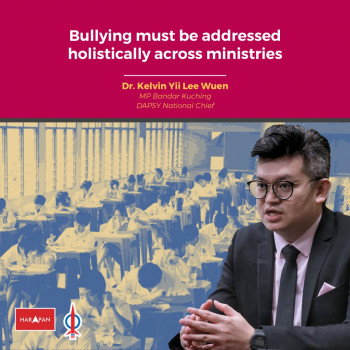By Serdang MP Ong Kian Ming
 Having served as an MP for one and a half years and having worked with councillors in the Subang Jaya and Kajang local councils (MPSJ and MPKJ respectively), I understand and appreciate the role of local councillors much more than before. Local councillors, in many ways, represent the first responders to the problems faced by residents be it the illegal dumping of rubbish, clogged drains or potholes. In a mature democracy, elected representatives at the national and state levels should focus on legislative matters while local councillors should focus on matters to do with the local council.
Having served as an MP for one and a half years and having worked with councillors in the Subang Jaya and Kajang local councils (MPSJ and MPKJ respectively), I understand and appreciate the role of local councillors much more than before. Local councillors, in many ways, represent the first responders to the problems faced by residents be it the illegal dumping of rubbish, clogged drains or potholes. In a mature democracy, elected representatives at the national and state levels should focus on legislative matters while local councillors should focus on matters to do with the local council.
In Malaysia, local councillors are appointed by the state government. Many of them are unknown to local residents, even in the areas which they are supposed to take care of. One of the main reasons behind the relative anonymity of the local councillors is because they are not elected. I can assure you that any elected representative in Malaysia would have gotten telephone calls asking for us to take care of their rubbish problems because “we elected you”. They cannot say the same of the local councillors.
In the current set-up, local councillors are beholden to the parties which appoint them rather than to the residents whom they are supposed to service. While a non-performing councillor may not continue to receive the recommendation from the elected MP or ADUN to continue his term as a councillor, the question of accountability still remains. A poorly performing councillor can remain in his position as long as he is ‘protected’ by the party. In areas where the elected representative is from a different party from the councillor, the line of reporting and accountability becomes even less clear.
Hence, local elections are the most effective way to restore the link between residents and their local councillor. Local councillors will have to campaign in order to be elected. They will have to make election pledges and produce election manifestos. Their profile among residents will be raised. Their accountability to the residents who voted them into office will also increase. This is arguably the most important reasons for the restoration of local elections.
Better reflection of local political representation
As it stands, it is a zero sum game at the local council level for political parties. Whoever controls the state government, controls the appointment of ALL councillors regardless of political support of the respective parties at the local level.
For example, PAS may have won all four state seats and the parliaments seat of Kuala Terengganu but they have no representation whatsoever in the Kuala Terengganu City Council. Similarly, UMNO won 7 out of the 21 state seats in Seberang Prai but they have zero representation in the Seberang Perai Municipal Council. Pakatan Rakyat won 9 out of 11 parliament seats in KL but have no representation whatsoever in Kuala Lumpur City Council.
Restoring local elections would better reflect the local political representation for all sides be it Barisan Nasional or Pakatan Rakyat.
Local elections will not necessarily result in DAP dominating the contests in urban areas for two reasons. Firstly, the emergence of other parties and political forces will likely be the strongest in the urban areas. It will not be surprisingly for candidates representing green interests or even a green party to win representative in local council elections. Single issue candidates such as an anti-KIDEX or a pro-animal position are much more likely to win local council elections in Petaling Jaya compared to non-urban districts where mobilization based on a single issue is much more challenging.
Secondly, the ethnic composition of many of the urban councils have changed significantly since the May 13th incident in 1969. The large migration of Malays from the rural to the urban areas have made areas like Kuala Lumpur very different from today from what it was in 1969. According to the 2010 census data, the Malay population in Wilayah Persekutuan KL (45.9%) outnumber the Chinese population (43.2%). In fact, out of the 3 city halls, 9 city councils and 37 municipal councils in Malaysia, only 6 have populations where the Chinese outnumber the Malays – Ipoh, Kuching Selantan, Johor Bahru Tengah, Pulau Pinang, Sibu and Subang Jaya![2] In other words, 88% of these large urban areas have a plurality and in most cases, a majority, of Malay residents. Even in a place like Petaling Jaya, the Malay population (46.2%) outnumber the Chinese population (39.6%)! (See Appendix 1 below)
While the Malays may be slightly under represented in the voting population in some of these urban areas because of their younger demographic profile, it is clearly wrong to say that the DAP will dominate local elections on the basis that urban areas are largely Chinese dominated.
More transparency in the budgetary process
My final argument as to why local elections need to be restored is in term of budgetary transparency and oversight. Currently, there is very little debate or deliberation as to how a local council’s budget is allocated. This matters since it determines how many playgrounds get upgraded, how many overhead bridges get built, how much is spend on rubbish collection and public cleansing, how much is used for landscaping, just to give a few examples.
With a more accountable elected local council coupled with a more politically accurate representation of local councillors, there will be a better check and balance over how the local council budget will be spent. Similar to how the opposition at the federal and state levels are supposed to scrutinize the government budgets of the federal and state governments, a more representative council should also do the same for the local council budget.
Conclusion
While there may be some legitimate concerns over having local elections e.g. the kind of electoral system to use, the specific powers of the local councillors, who can vote in these elections, just to mention a few, the possibility of a May 13thlike event happening as a result of local elections is not one of them.
Appendix 1: Ethnic Composition of the 3 City Halls, 9 City Councils and 37 Municipal Councils in Malaysia according to the 2010 Census Data
| No | City Hall / City Council / Municipal Council | Malay / Bumiputera | Cina | India | Lain-Lain | |||
| 1 | Kuala Lumpur | 45.9 | 43.2 | 10.3 | 0.6 | |||
| 2 | Kota Kinabalu | 70.4 | 27.4 | 0.6 | 1.6 | |||
| 3 | Kuching Utara | 84.8 | 14.5 | 0.4 | 0.2 | |||
| 4 | Johor Bahru | 54.1 | 38 | 7.3 | 0.6 | |||
| 5 | Aor Setar | 76.9 | 20.4 | 2.3 | 0.4 | |||
| 6 | Melaka Bandaraya Bersejarah | 60.6 | 34.3 | 4.4 | 0.7 | |||
| 7 | Ipoh* | 39.8 | 45.5 | 14.5 | 0.2 | |||
| 8 | Kuching Selatan* | 36.4 | 62.5 | 0.6 | 0.5 | |||
| 9 | Miri | 65 | 34.1 | 0.5 | 0.4 | |||
| 10 | Petaling Jaya | 46.2 | 39.6 | 13.3 | 0.9 | |||
| 11 | Shah Alam | 71.1 | 16.7 | 11.2 | 1 | |||
| 12 | Kuala Terengganu | 96.2 | 3.5 | 0.3 | 0.1 | |||
| 13 | Batu Pahat | 53.4 | 44.7 | 1.7 | 0.3 | |||
| 14 | Johor Bahru Tengah* | 38.8 | 47.2 | 13.4 | 0.6 | |||
| 15 | Pasir Gudang | 91.4 | 2.7 | 5.4 | 0.5 | |||
| 16 | Kluang | 47.1 | 42.6 | 9.9 | 0.5 | |||
| 17 | Muar | 54 | 42.9 | 2.8 | 0.3 | |||
| 18 | Kulai | 50.2 | 37.7 | 11.5 | 0.5 | |||
| 19 | Sungai Petani | 66.2 | 19.4 | 13.9 | 0.5 | |||
| 20 | Kulim | 63.6 | 17.4 | 18.7 | 0.3 | |||
| 21 | Langkawi Bandaraya Pelancongan | 92.6 | 5.1 | 2 | 0.3 | |||
| 22 | Kota Bharu Bandaraya Islam | 93.1 | 6.3 | 0.4 | 0.3 | |||
| 23 | Alor Gajah | 77.5 | 14.4 | 8 | 0.2 | |||
| 24 | Jasin | 76 | 13.1 | 10.7 | 0.2 | |||
| 25 | Port Dickson | 52.4 | 27.3 | 19.9 | 0.4 | |||
| 26 | Seremban | 50.9 | 32.6 | 16.1 | 0.4 | |||
| 27 | Nilai | 63.2 | 17.5 | 18.8 | 0.5 | |||
| 28 | Bentong | 57.3 | 33.3 | 9.1 | 0.3 | |||
| 29 | Kuantan | 78.5 | 17.9 | 3.3 | 0.3 | |||
| 30 | Temerloh | 75.7 | 15.8 | 7.8 | 0.7 | |||
| 31 | Manjung | 54.7 | 31.7 | 13.4 | 0.2 | |||
| 32 | Kuala Kangsar | 50.1 | 31.5 | 18.2 | 0.2 | |||
| 33 | Taiping | 53.4 | 33.1 | 13.3 | 0.2 | |||
| 34 | Teluk Intan | 38.8 | 39 | 22 | 0.2 | |||
…



